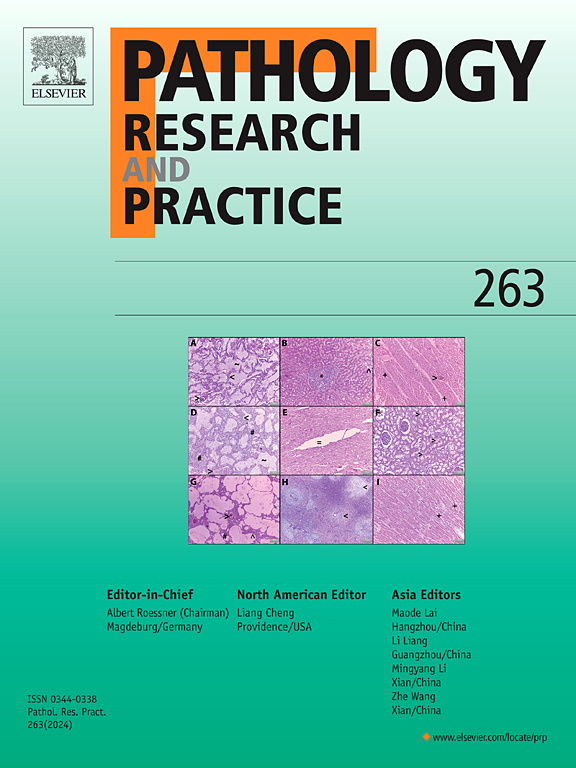Integrative transcriptomic and single-cell protein characterization of colorectal carcinoma delineates distinct tumor immune microenvironments associated with overall survival
IF 3.2
4区 医学
Q2 PATHOLOGY
引用次数: 0
Abstract
Purpose
Colorectal carcinoma (CRC) is a heterogeneous group of tumors with varying therapeutic response and prognosis, and evidence suggests the tumor immune microenvironment (TIME) plays a pivotal role. Using advanced molecular and spatial biology technologies, we aimed to evaluate the TIME in patients with CRC to determine whether specific characteristics of immune composition correlated with prognosis.
Methods
We identified primary and metastatic tumor samples from 31 consented patients, which were profiled with whole-exome sequencing and bulk RNA-seq. Immune cell deconvolution followed by gene set enrichment analysis and unsupervised clustering was performed. A subset of tumors underwent in situ analysis of the TIME spatial composition at single-cell resolution through Imaging Mass Cytometry.
Results
Gene set enrichment analysis revealed two distinct groups of advanced CRC, one with an immune activated phenotype and the other with a suppressed immune microenvironment. The activated TIME phenotype contained increased Th1 cells, activated dendritic cells, tertiary lymphoid structures, and higher counts of CD8 + T cells whereas the inactive or suppressed TIME contained increased macrophages enriched for immunosuppressive M2 macrophages. Our findings were further supported by RNA-seq data analysis from the TCGA CRC database, in which the ratio of inactivated to activated dendritic cells within the CRC TIME correlated with a lower overall survival probability (HR 1.66, p = 0.007).
Conclusion
We identified distinct immunologic tumor microenvironments in colorectal cancer. Cancers harboring an activated TIME are associated with improved survival. Identifying key molecular drivers of the CRC TIME may offer opportunities to improve patient survival.
结直肠癌的整合转录组学和单细胞蛋白表征描绘了与总生存相关的不同肿瘤免疫微环境
目的结直肠癌(CRC)是一种异质性的肿瘤,治疗反应和预后各不相同,有证据表明肿瘤免疫微环境(TIME)在其中起着关键作用。利用先进的分子和空间生物学技术,我们旨在评估CRC患者的TIME,以确定免疫组成的特定特征是否与预后相关。方法:我们从31例同意的患者中鉴定原发和转移性肿瘤样本,采用全外显子组测序和大量RNA-seq对其进行分析。免疫细胞反褶积,然后进行基因集富集分析和无监督聚类。肿瘤的一个子集通过成像细胞术在单细胞分辨率下进行了TIME空间组成的原位分析。结果基因集富集分析揭示了两组不同的晚期结直肠癌,一组具有免疫激活表型,另一组具有免疫微环境抑制。活化的TIME表型含有增加的Th1细胞、活化的树突状细胞、三级淋巴样结构和更高计数的CD8 + T细胞,而不活化或抑制的TIME表型含有增加的巨噬细胞,富集免疫抑制的M2巨噬细胞。来自TCGA CRC数据库的RNA-seq数据分析进一步支持了我们的研究结果,其中CRC TIME内失活与活化树突状细胞的比例与较低的总生存率相关(HR 1.66, p = 0.007)。结论结直肠癌中存在不同的免疫肿瘤微环境。携带激活时间的癌症与生存率的提高有关。确定结直肠癌时间的关键分子驱动因素可能为提高患者生存率提供机会。
本文章由计算机程序翻译,如有差异,请以英文原文为准。
求助全文
约1分钟内获得全文
求助全文
来源期刊
CiteScore
5.00
自引率
3.60%
发文量
405
审稿时长
24 days
期刊介绍:
Pathology, Research and Practice provides accessible coverage of the most recent developments across the entire field of pathology: Reviews focus on recent progress in pathology, while Comments look at interesting current problems and at hypotheses for future developments in pathology. Original Papers present novel findings on all aspects of general, anatomic and molecular pathology. Rapid Communications inform readers on preliminary findings that may be relevant for further studies and need to be communicated quickly. Teaching Cases look at new aspects or special diagnostic problems of diseases and at case reports relevant for the pathologist''s practice.

 求助内容:
求助内容: 应助结果提醒方式:
应助结果提醒方式:


